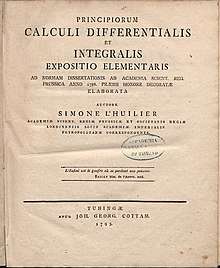Simon Antoine Jean L'Huilier
Simon Antoine Jean L'Huilier (or L'Huillier) (24 April 1750 in Geneva – 28 March 1840 in Geneva) was a Swiss mathematician of French Hugenot descent. He is known for his work in mathematical analysis and topology, and in particular the generalization of Euler's formula for planar graphs.[1]

He won the mathematics section prize of the Berlin Academy of Sciences for 1784 in response to a question on the foundations of the calculus. The work was published in his 1787 book Exposition elementaire des principes des calculs superieurs. (A Latin version was published in 1795.) Although L'Huilier won the prize, Joseph Lagrange, who had suggested the question and was the lead judge of the submissions, was disappointed in the work, considering it "the best of a bad lot." Lagrange would go on to publish his own work on foundations.
L'Huilier and Cauchy
L'Huilier introduced the abbreviation "lim" for limit that reappeared in 1821 in Cours d'Analyse by Augustin Louis Cauchy, who would later create his approach based on infinitesimals defined in terms of variable quantities.[2][3]
Royal Society fellow
He was elected in May, 1791 a Fellow of the Royal Society [4]
Note that this surname is sometimes rendered as Lhuilier or Lhuillier.
Notes
- L'Huilier, S.-A.-J. (1812–1813). "Mémoire sur la polyèdrométrie". Annales de Mathématiques. 3: 169–189.
- Grabiner, Judith V. (1981). The Origins of Cauchy's Rigorous Calculus. Dover. pp. 40–42. ISBN 0-486-43815-5.
- Borovik, Alexandre; Katz, Mikhail G. (2011), "Who gave you the Cauchy--Weierstrass tale? The dual history of rigorous calculus", Foundations of Science, arXiv:1108.2885, doi:10.1007/s10699-011-9235-x
- "Library and Archive catalogue". The Royal Society. Retrieved 2019-06-04.
External links
- O'Connor, John J.; Robertson, Edmund F., "Simon Antoine Jean L'Huilier", MacTutor History of Mathematics archive, University of St Andrews.